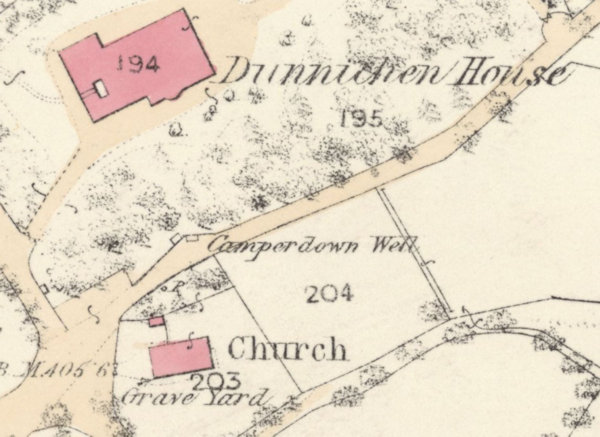 |
Dedication: Saint Causnan? Location: Dunnichen Coordinates: 56.62855N, -2.80108W Grid reference: NO509488 Heritage designation: none |
 |
Dedication: Saint Causnan? Location: Dunnichen Coordinates: 56.62855N, -2.80108W Grid reference: NO509488 Heritage designation: none |
It is not clear who exactly St Causnan was. It is possible that Causnan was a minor local saint who had a specific connection to Dunnichen and nowhere else, perhaps living here as a hermit. However, it has also been suggested that Causnan may be a corruption of the name "Constantine", a title that several Scottish saints went by. Specifically, the most probable candidates for the true identity of St Causnan (assuming that he was not a local hermit) are Constantine of Rahan, a possibly legendary King of Britain who was also called "Custantin", and Constantine of the Britons, a possibly legendary King of Cornwall; to complicate this even more, these two Constantines may really be one and the same. Personally, I lean more towards the possibility that Causnan was a local hermit or saintly figure.
What is known for certain is that there was a medieval chapel of St Causnan located somewhere in the vicinity of the holy well, which was later replaced by today's parish church. Traditionally, it is said that this chapel was located at NO 51194880, slightly to the east of the newer church, although no stones were turned up when the field was ploughed, so it seems rather doubtful that the chapel really was here. Instead, it is probably more likely that the chapel was located on the same site that the newer church occupies today. Regardless, water from St Causnan's Well was almost certainly used for baptisms.
Annually, the fair of St Causnan was held at Dunnichen on the 11th of March, and, in the medieval period, it was an important event. By the late 19th century, however, the fair was poorly attended, and the custom is no longer observed. The fair was not the only way in which Causnan was remembered in the parish: according to the Statistical Account of Scotland (1791), "falls of ſnow" were, even at the close of the 18th century, locally called "St Cauſnan's Flaw".
Very little is known regarding the history of St Causnan's Well itself, although it probably dates from around the same time as the old chapel. Originally, it appears that it was accessible from the roadside, and it was almost certainly the area's main water supply. In 1797, following the victory of Admiral Duncan at the Battle of Camperdown, the well was re-christened "Camperdown Well". This name stuck, and the site has always been given this title on Ordnance Survey maps. Alex J. Warden, writing in volume 3 of Angus or Forfarshire, the Land and People in 1880, described what had happened to the well in 1797:
|
St Causnan's well, a fine spring of clear cool water, was in the vicinity of the Church. Immediately after the glorious victory of Camperdown was gained by Admiral Duncan, George Dempster, then proprietor of the estate of Dunnichen, placed a marble slab at the well, on which is inscribed ONCE SAINT COUSAN'S, |
Today, it St Causnan's Well is still marked on Ordnance Survey maps, although it is no longer accessible from the roadside. Its exact condition is currently unknown, and it is not clear whether the "marble slab" is still extant.
|
Access: The well is located on private land. |
Images:
Old OS maps are reproduced with the permission of the National Library of Scotland
Copyright 2025 britishholywells.co.uk